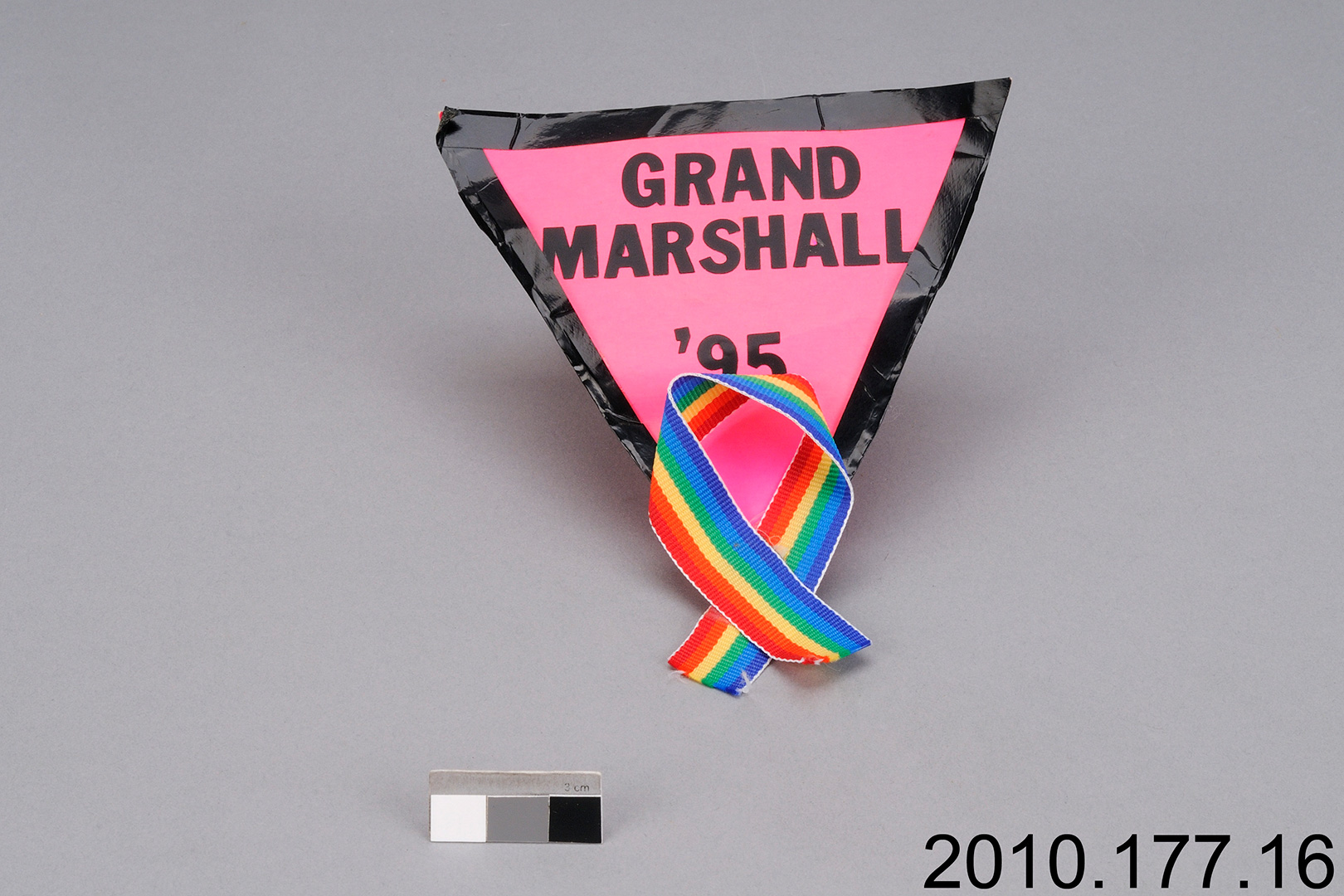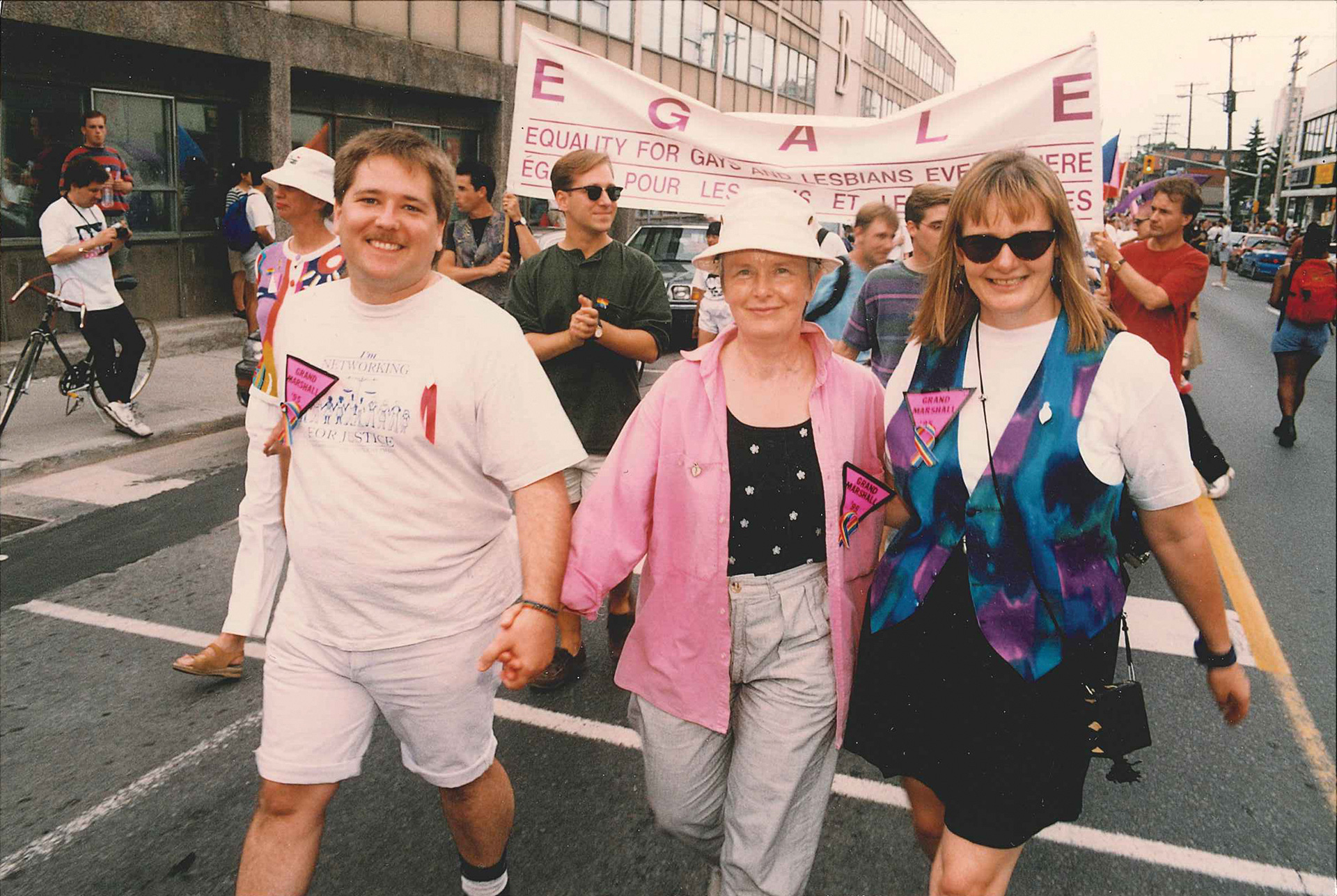Carroll Holland Pride Pin
Artifact
Image
Video
Audio
 Activities
Activities
Look
Write down any feelings you associate with the colours you see on this badge and ribbon.
Do
Research the history of the 2SLGBTQIA+ flag, and identify the various flags that represent different gender and sexual identities. How and why has the design changed? What are the meanings behind the changes?
Do
Review the first Pride marches in Montréal and Toronto, and describe how they are different or similar than the 1995 Ottawa Capital Pride March Parade, when Holland was “Grand Marshall.”
Details
 Materials
Materials - Metal
- Paper
- Ink
- Synthetic fibres
Historical Context
Choose one of the three levels below to match your needs.
- This “Grand Marshall” pin and t-shirt were worn by Carroll Holland (she/her/hers) at the 1995 Ottawa Capital Pride Festival Parade.
- Carroll devoted a lot of time volunteering for various 2SLGBTQIA+ organizations and initiatives — including a special liaison committee with Ottawa Police Services — in order to improve relations between police and the community.
- The inverted pink triangle and rainbow ribbon are international symbols for 2SLGBTQIA+ communities.
This pink “Grand Marshall” pin and t-shirt were worn by Carroll Holland (she/her/hers) during the 1995 Ottawa Capital Pride Parade.
Holland, an Ottawa-based journalist, helped to create a special committee for Ottawa’s 2SLGBTQIA+ community and police representatives to discuss shared concerns, improve relations, and launch targeted initiatives around partner-based violence.
Many 2SLGBTQIA+ community members have mixed feelings about the role and presence of police within their communities. Some refuse to work with or include police officers in their celebrations or activities, while others have advocated for a more conciliatory approach.
The pink triangle in the pin is used by 2SLGBTQIA+ groups worldwide as a symbol of anti-oppression and solidarity. Its origins in Nazi Germany, where gay prisoners were forced to wear an inverted pink triangle in concentration camps, make it a powerful symbol to the community today. The multi-coloured ribbon at the bottom evokes the rainbow flag — a common emblem of the community since the 1970s.
This pink “Grand Marshall” pin and t-shirt were worn by Ottawa-based journalist Carroll Holland (she/her/hers) during the 1995 Ottawa Capital Pride Festival Parade.
A history of discrimination has led many Pride festival organizers and participants to have mixed feelings about police in their communities. Some refuse to work with or include police officers in their celebrations or activities, while others have advocated for a more conciliatory approach.
Carroll came out as a lesbian in her 40s. She sought to put her skills as a journalist, and her Buddhist faith, into practice by helping to create a special committee for Ottawa’s 2SLGBTQIA+ community and police representatives to discuss shared concerns, improve relations, and launch targeted initiatives around partner-based violence.
Carroll’s community work was recognized in 1995 when she was invited to be one of the grand marshals of Ottawa’s Pride Festival Parade. She wore this pin and a pink shirt in the parade that year.
The pin’s pink triangle is used by 2SLGBTQIA+ groups worldwide as a symbol of anti-oppression and solidarity. Although the pink triangle was originally used in Nazi Germany to identify gay prisoners in concentration camps, the symbol has been reclaimed by many members of the 2SLGBTQIA+ community today.
The multi-coloured ribbon at the bottom of the pin evokes the rainbow flag — a common emblem of the community since the 1970s.
- This “Grand Marshall” pin and t-shirt were worn by Carroll Holland (she/her/hers) at the 1995 Ottawa Capital Pride Festival Parade.
- Carroll devoted a lot of time volunteering for various 2SLGBTQIA+ organizations and initiatives — including a special liaison committee with Ottawa Police Services — in order to improve relations between police and the community.
- The inverted pink triangle and rainbow ribbon are international symbols for 2SLGBTQIA+ communities.
This pink “Grand Marshall” pin and t-shirt were worn by Carroll Holland (she/her/hers) during the 1995 Ottawa Capital Pride Parade.
Holland, an Ottawa-based journalist, helped to create a special committee for Ottawa’s 2SLGBTQIA+ community and police representatives to discuss shared concerns, improve relations, and launch targeted initiatives around partner-based violence.
Many 2SLGBTQIA+ community members have mixed feelings about the role and presence of police within their communities. Some refuse to work with or include police officers in their celebrations or activities, while others have advocated for a more conciliatory approach.
The pink triangle in the pin is used by 2SLGBTQIA+ groups worldwide as a symbol of anti-oppression and solidarity. Its origins in Nazi Germany, where gay prisoners were forced to wear an inverted pink triangle in concentration camps, make it a powerful symbol to the community today. The multi-coloured ribbon at the bottom evokes the rainbow flag — a common emblem of the community since the 1970s.
This pink “Grand Marshall” pin and t-shirt were worn by Ottawa-based journalist Carroll Holland (she/her/hers) during the 1995 Ottawa Capital Pride Festival Parade.
A history of discrimination has led many Pride festival organizers and participants to have mixed feelings about police in their communities. Some refuse to work with or include police officers in their celebrations or activities, while others have advocated for a more conciliatory approach.
Carroll came out as a lesbian in her 40s. She sought to put her skills as a journalist, and her Buddhist faith, into practice by helping to create a special committee for Ottawa’s 2SLGBTQIA+ community and police representatives to discuss shared concerns, improve relations, and launch targeted initiatives around partner-based violence.
Carroll’s community work was recognized in 1995 when she was invited to be one of the grand marshals of Ottawa’s Pride Festival Parade. She wore this pin and a pink shirt in the parade that year.
The pin’s pink triangle is used by 2SLGBTQIA+ groups worldwide as a symbol of anti-oppression and solidarity. Although the pink triangle was originally used in Nazi Germany to identify gay prisoners in concentration camps, the symbol has been reclaimed by many members of the 2SLGBTQIA+ community today.
The multi-coloured ribbon at the bottom of the pin evokes the rainbow flag — a common emblem of the community since the 1970s.
Summary
- This “Grand Marshall” pin and t-shirt were worn by Carroll Holland (she/her/hers) at the 1995 Ottawa Capital Pride Festival Parade.
- Carroll devoted a lot of time volunteering for various 2SLGBTQIA+ organizations and initiatives — including a special liaison committee with Ottawa Police Services — in order to improve relations between police and the community.
- The inverted pink triangle and rainbow ribbon are international symbols for 2SLGBTQIA+ communities.
Essential
This pink “Grand Marshall” pin and t-shirt were worn by Carroll Holland (she/her/hers) during the 1995 Ottawa Capital Pride Parade.
Holland, an Ottawa-based journalist, helped to create a special committee for Ottawa’s 2SLGBTQIA+ community and police representatives to discuss shared concerns, improve relations, and launch targeted initiatives around partner-based violence.
Many 2SLGBTQIA+ community members have mixed feelings about the role and presence of police within their communities. Some refuse to work with or include police officers in their celebrations or activities, while others have advocated for a more conciliatory approach.
The pink triangle in the pin is used by 2SLGBTQIA+ groups worldwide as a symbol of anti-oppression and solidarity. Its origins in Nazi Germany, where gay prisoners were forced to wear an inverted pink triangle in concentration camps, make it a powerful symbol to the community today. The multi-coloured ribbon at the bottom evokes the rainbow flag — a common emblem of the community since the 1970s.
In-Depth
This pink “Grand Marshall” pin and t-shirt were worn by Ottawa-based journalist Carroll Holland (she/her/hers) during the 1995 Ottawa Capital Pride Festival Parade.
A history of discrimination has led many Pride festival organizers and participants to have mixed feelings about police in their communities. Some refuse to work with or include police officers in their celebrations or activities, while others have advocated for a more conciliatory approach.
Carroll came out as a lesbian in her 40s. She sought to put her skills as a journalist, and her Buddhist faith, into practice by helping to create a special committee for Ottawa’s 2SLGBTQIA+ community and police representatives to discuss shared concerns, improve relations, and launch targeted initiatives around partner-based violence.
Carroll’s community work was recognized in 1995 when she was invited to be one of the grand marshals of Ottawa’s Pride Festival Parade. She wore this pin and a pink shirt in the parade that year.
The pin’s pink triangle is used by 2SLGBTQIA+ groups worldwide as a symbol of anti-oppression and solidarity. Although the pink triangle was originally used in Nazi Germany to identify gay prisoners in concentration camps, the symbol has been reclaimed by many members of the 2SLGBTQIA+ community today.
The multi-coloured ribbon at the bottom of the pin evokes the rainbow flag — a common emblem of the community since the 1970s.


